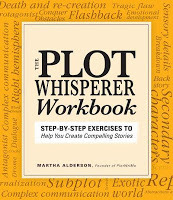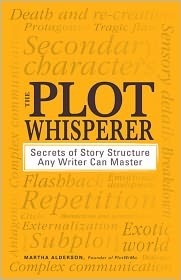The Plot Whisperer: Benefits of Plotting in Scenes + GIVEAWAY
 I am triple-fudge-sundae excited to welcome Martha Alderson (aka The PLOT WHISPERER) to The Bookshelf Muse as she sends The Plot Whisperer Workbook: Step-by-Step Exercises to Help You Create Compelling Stories
I am triple-fudge-sundae excited to welcome Martha Alderson (aka The PLOT WHISPERER) to The Bookshelf Muse as she sends The Plot Whisperer Workbook: Step-by-Step Exercises to Help You Create Compelling Stories off into the world. This workbook is a companion to the incredibly popular The Plot Whisperer: Secrets of Story Structure Any Writer Can Master
off into the world. This workbook is a companion to the incredibly popular The Plot Whisperer: Secrets of Story Structure Any Writer Can Master . Martha as you may remember, was featured as a Writing Hero not too long ago, and in true helping fashion, is generously offering a copy of her new Plot Whisperer Workbook to 3 lucky commenters!
. Martha as you may remember, was featured as a Writing Hero not too long ago, and in true helping fashion, is generously offering a copy of her new Plot Whisperer Workbook to 3 lucky commenters!Here's Martha on the Benefits of Plotting in Scenes!
~ ~ ~
Some writers write by the seat of their pants. Others prefer to pre-plot first, write after. Some write and plot, write and plot, write and plot. Eventually, every writer who sticks with her writing achieves a draft or a partial made up of scenes. The leap from the generative stage of writing scenes to the analytical stage of analyzing what you have written often leave writers frozen or in a tangled heap.
 Analyze Your Plot by Scenes
Analyze Your Plot by ScenesIn a scene a character acts and reacts to people, places, and events. In this respect, scenes are the basic building blocks of your story. But, as with any structure, if you have the wrong scenes or if they’re assembled incorrectly, your story can—unexpectedly—collapse.
Before you can create a visual map for analyzing critical story information, presentation flow, and the overall story sequence, you have to have scenes. Likely, you have heard the writer’s mantra: “Show, don’t tell.” Summary tells. Scenes show.
I use the following partial scene from the middle-grade Newbery Medal-winning novel Holes by Louis Sachar, an example for analyzing a scene from my workbook.
Stanley Yelnats has been unjustly sent to a boys’ detention center where the boys build character by spending all day, every day, digging holes exactly five feet wide and five feet deep.
[Stanley] glanced helplessly at his shovel. It wasn’t defective. He was defective. He noticed a thin crack in the ground. He placed the point of his shovel on top of it, then jumped on the back of the back with both feet.The shovel sank a few inches into the packed earth.He smiled. For once in his life it paid to be overweight.He leaned on the shaft and pried up his first shovelful of dirt, then dumped it off to the side.Only ten million more to go, he thought, then placed the shovel back in the crack and jumped on it again.He unearthed several shovelfuls of dirt in this manner, before it occurred to him that he was dumping his dirt within the perimeter of his hole. He laid his shovel flat on the ground and marked where the edges of his hole would be. Five feet was awfully wide. He moved the dirt he’d already dug up out past his mark. He took a drink from his canteen. Five feet would be awfully deep, too.
Scenes that Show Emotion
This scene, as do all good scenes, shows moment-to-moment action in real story time. The reader experiences the work as Stanley does it and learns about the protagonist, not because the author tells us but because he shows us through Stanley’s actions. We learn the protagonist is overweight and can laugh at himself. We learn he has staying power because rather than give up and suffer the consequences he finds a way to break the earth open. We learn he is bright in that he quickly realizes his mistake in dumping the dirt within the perimeter of his hole and immediately rectifies the situation.
The details of Stanley jumping on the back of the shovel blade with both feet, leaning on the shaft, measuring the hole, and taking a drink from his canteen draw the reader into the moment of the scene. The reader attaches viscerally to the fleeting happiness Stanley feels at being heavy enough to sink the shovel a few inches into the packed earth, his despondency when he understands how wide five feet actually is, his momentary success in prying up his first shovelful, and his disappointment in counting “only ten million more to go”––not to mention his despair when he acknowledges the full magnitude of the task in front of him.
 Create a List of Scenes
Create a List of Scenes A partial list of scenes from the beginning of the award-winning middle grade novel Esperanza Rising by Pam Munoz Ryan is an example used in the companion Plot Whisperer Workbook.
The novel is set during the time of the American Great Depression and is about a young Mexican girl, who’s sense of self is stripped when she and her mother are forced to leave their life of privilege in Mexico for an uncertain future in the United States as farm workers.
In analyzing Esperanza Rising, create a list of the novel’s scenes (we only went a couple of scenes past the one-quarter mark and into the middle of the story). For your exercise, list your scenes all the way to the end of your story. Shorten scene titles while still capturing the major plot elements of the scene. Each scene title should take up no more than one line of the following scene list.
It’s not necessary for you to have written all (or any) of your scenes. Just list scene ideas in the order in which you envision them landing in your story. If your book is made up of many small chapters, each one encapsulating a scene, list events in the story by chapter.
The trick to this exercise is not to see how many scenes you can list. Instead, you want to identify and list scenes that advance the story on a multitude of plot levels.
Remember that it may take you several tries before you get the list in an order that satisfies you. For this reason, I recommend using a pencil instead of a pen, so you can erase parts of your first ordering and move scenes around. Also remember that it’s often a good idea to try out this exercise using scenes from a favorite book. The more you practice this analysis and construction, the better you’ll get at it.
~ ~ ~
 Martha Alderson, aka the Plot Whisperer, is the author of The Plot Whisperer Workbook: Step-by-Step Exercises to Help You Create Compelling Stories
Martha Alderson, aka the Plot Whisperer, is the author of The Plot Whisperer Workbook: Step-by-Step Exercises to Help You Create Compelling Stories
– a companion workbook to The Plot Whisperer: Secrets of Story Structure Any Writer Can Master
 (Adams Media, a division of F + W Media). She has also written Blockbuster Plots: Pure & Simple
(Adams Media, a division of F + W Media). She has also written Blockbuster Plots: Pure & Simple (Illusion Press) and several ebooks and dvds on plot, including a dvd for writers of children’s and young adult novels. As an international plot consultant for writers, Martha’s clients include best-selling authors, New York editors, and Hollywood movie directors. She teaches plot workshops to novelists, memoirists, and screenwriters privately, at plot retreats, through Learning Annex, RWA, SCBWI, CWC chapter meetings, at writers' conferences and Writers Store where she takes writers beyond the words and into the very heart of a story.
(Illusion Press) and several ebooks and dvds on plot, including a dvd for writers of children’s and young adult novels. As an international plot consultant for writers, Martha’s clients include best-selling authors, New York editors, and Hollywood movie directors. She teaches plot workshops to novelists, memoirists, and screenwriters privately, at plot retreats, through Learning Annex, RWA, SCBWI, CWC chapter meetings, at writers' conferences and Writers Store where she takes writers beyond the words and into the very heart of a story.As the founder of Blockbuster Plots for Writers and December, International Plot Writing Month, Martha manages an award-winning blog for writers, awarded by Writers Digest 2009, 2010, 2011, 2012. Her vlog, How Do I Plot a Novel, Memoir, Screenplay covers 27 steps to plotting your story from beginning to end. Find her on Twitter, and if you like, add her workbook to your Goodreads list!
Would you like to take your writing to the next level with Martha's intuitive Plot Whisperer Workbook? This giveaway is open internationally, so just leave a comment with some contact info and share if you plot your scenes already, or if this is a technique you'd like to try. As always, tweets and shares are greatly appreciated. Good luck, everyone!

Published on August 23, 2012 03:41
No comments have been added yet.
Writers Helping Writers
A place for writers to find support, helpful articles on writing craft, and an array of unique (and free!) writing tools you can't find elsewhere. We are known far and wide for our "Descriptive Thesau
A place for writers to find support, helpful articles on writing craft, and an array of unique (and free!) writing tools you can't find elsewhere. We are known far and wide for our "Descriptive Thesaurus Collections" which help authors create vivid imagery and sensory detail for their Settings, Characters (physical descriptions, emotions, skills & talents, etc.), Symbolism, Weather, and a whole bunch more. Stop in and say hello! :) http://writershelpingwriters.net/
...more
- Angela Ackerman's profile
- 1022 followers



